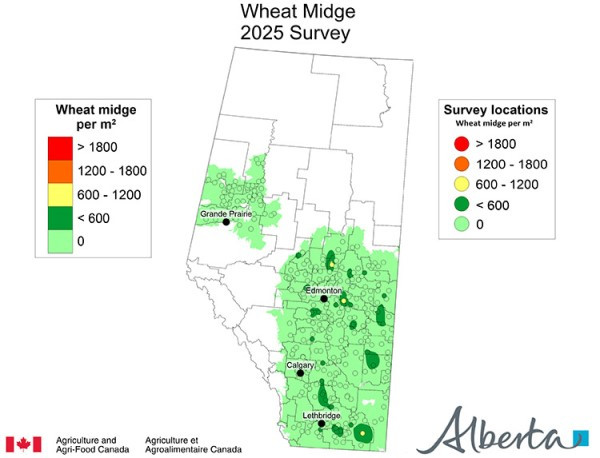Government mail service may be affected by the Canada Post labour disruption. Learn about how critical government mail will be handled.
This is not a forecast. It is a summary of the situation in Alberta in 2025.
Overview
In 2025, wheat midge populations were low across the province.
Numbers of the parasitoid Macroglenes penetrans increased in 2025, with an overall parasitism rate of 23%.
Even though the map may indicate that there is not a risk for midge in a specific area, that does not mean that there is no risk. Historically, field-to-field variation has been considerable for this insect and individual fields may have economic levels of midge.
For information on identification, life cycle, damage and pest management, see Wheat midge – Overview.
Methodology
In total, 298 samples were taken from 62 counties. The survey involves taking soil samples from wheat fields after harvest using a standard soil probe. Larval cocoons are washed out of the soil using a specialized series of screens. Larvae are counted and then dissected to determine parasitism levels in the midge. The midge density displayed on the forecast map is based on viable (live, non-parasitized) midge larvae.
2025 survey findings
Low numbers of wheat midge were found distributed throughout the province, except in the Peace Region, where none were found. Wheat development in the Peace region was well ahead of the long-term average at the time when adult wheat midge pheromone trap capture peaked, so the midge may have missed susceptible wheat growth stages.
Trap capture from pheromone baited traps indicated wheat midge emergence peaked during the second week of July over most of the province.
Overall parasitism rates were 23% in infested fields, increasing from 6% in 2024. In fields where parasitoids were present, rates varied from 25% to 50%. Parasitism rates were particularly high in central Alberta. Adequate moisture conditions can be even more important for the parasitoids than for the midge.
This map is not intended to take the place of monitoring populations in individual fields as populations of this insect often are highly variable.
When considering preventative control strategies such as seed treatment for the 2026 crop year, producers should refer to indicators specific to their farm as well as the information generated from this survey. Specifically, producers should pay attention to midge downgrading in their wheat samples and use this as an indication of midge risk in their fields.
Producers should plan to monitor their fields when the midge adults are flying and wheat is in the susceptible stage, from the boot crack until anthers are visible on the heads.
Regular field scouting on multiple nights in succession is important in understanding the population in a particular field. Look for the results of our wheat midge pheromone trapping in June and July to help track adult midge emergence and time in-field scouting.
Although a number of factors influence the overwintering survival of the midge, the survey and map provide a general picture of existing densities and the potential for infestation in 2026. Weather conditions, specifically temperature and moisture will ultimately determine the extent and timing of midge emergence during the growing season.
Temperature and wind also play critical roles in egg laying activities of the adult female wheat midge. The level of damage from wheat midge is determined by the synchrony of wheat midge emergence and wheat and the number of wheat midge present. Look for the results of our wheat midge pheromone trapping in June and July to help track adult midge emergence.
Parasitism of midge larvae by a small wasp species (Macroglens penetrans) has been important in keeping wheat midge populations below the economic threshold in many areas. These beneficial wasps tend to thrive in warm, dry conditions. Parasitoid populations increase and decrease with changes in the midge population and are very important in moderating population levels in Alberta.
It is important to understand that once midge has established in an area it unlikely to ever completely disappear. Low-lying and moist areas in fields provide a refuge, enabling the population to survive even when conditions are not favorable in the rest of the field. These low population levels, however, also help sustain a population of natural enemies.
Acknowledgements
Thank you to those who assisted with the wheat midge survey:
- Mountain View County
- Parkland County
- MD of Wainwright
- North Peace Applied Research Association
Thanks to all the agronomists and Agriculture Fieldmen who lined up fields and to the producers who offered their fields for the survey.
Thanks to Jon Williams from Agriculture and Agri-Food Canada, Saskatoon for producing this map.
Historical survey maps
- Wheat Midge Survey Map 2024
- Wheat Midge Survey Map 2023
- Wheat Midge Forecast Map 2023
- Wheat Midge Forecast Map 2022
- Wheat Midge Forecast Map 2021
- Wheat Midge Forecast Map 2020
- Wheat Midge Forecast Map 2019
- Wheat Midge Forecast Map 2018
- Wheat Midge Forecast Map 2017
- Wheat Midge Forecast Map 2016
- Wheat Midge Forecast Map 2015
- Wheat Midge Forecast Map 2014
- Wheat Midge Forecast Map 2013
- Wheat Midge Forecast Map 2012
- Wheat Midge Forecast Map 2011
- Wheat Midge Forecast Map 2010
- Wheat Midge Forecast Map 2009
- Wheat Midge Forecast Map 2008
- Wheat Midge Forecast Map 2007
- Wheat Midge Forecast Map 2006
